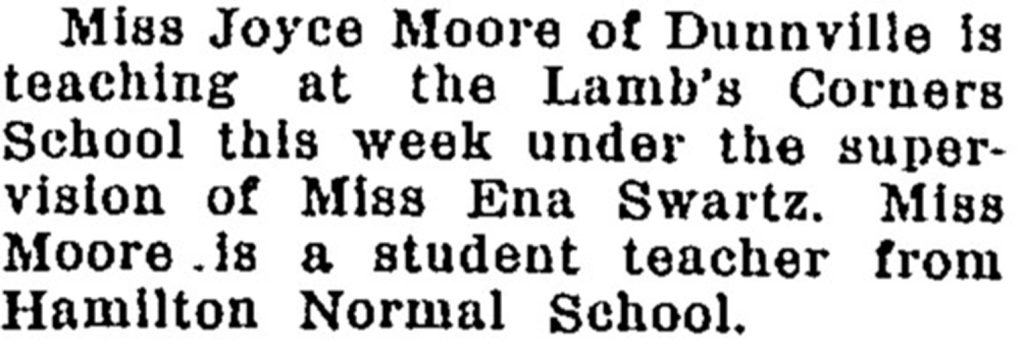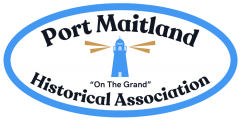January 2025
ARTICLES FROM 1955 DUNNVILLE CHRONICLE – PART II
It has been a while since my last Bill’s Post. I am taking you for a journey of the articles found in the Dunnville Chronicle of 1955. Each Bill’s Post will cover a three month’s section of the paper. Unfortunately as the papers were first scanned for microfilm and then scanned again to digitize them very few photos are of the quality that I can use for Bill’s Post.
I am also having a problem with the color of some of the paragraphs and cannot figure out how to correct this.
April 7, 1955

Who of us remember Dr. Mills and his many visits to our school to give use one shot or another? In S. S. #3 at Stromness we would all line up in the senior classroom downstairs and pull up our sleaves and wait anxiously for that painful jab in the arm. No matter the arm you expossed you would be instructed to bare your left arm. I am left handed which meant that it was always my dominant arm that would hurt for a day or two depending on the type of shot I received.
April 7, 1955

Seventy years ago this month, (June 1954) CHCH TV began broadcasting as a CBC affiliate with an inaugural one-and-a-half-hour variety program called “This is Hamilton.”
You can see they used the name, Mrs. Harold Hicks! That really bugs me when a woman would be called Mrs. “Harold”. She had a name and in Mrs. Harold Hicks case I believe her name was Dorothy the former Dorothy Jessie Bryan. Dorothy would be one of the very early interviewees at the new television station.
April 7, 1955

From The Sachem Unknown Date “The Grand Opera House was opened in Dunnville on October 1911. While originally dedicated to live performances, these gave way to movie screenings. In 1933, the name was changed to the Hollywood Theatre, and in 1938 it changed again to the Granada Theatre.”
From (The Exhibitor), a Motion Picture newsletter is a list of management moves which included “Mel Stephens, Centre, London, moved to the Granada, Dunnville replacing Pat Dunne, who moves to the Royal, North Bay.”
April 7, 1955

Anyone who grew up around Dunnville and is my age (76) no matter their particular faith will remember Rev. Emery Shank and his tabernacle. Rev. Shank had two wives, the first being Annie Irene Siddall and his second being a woman who could really rev up the Pentecostal movement. She was Mary Scott.
Rev. Tommy Hicks who I am certain is not related to the Dunnville Hicks family was an American preaches. Read more about him on this website.
April 7, 1955

April 14, 1955

I wonder who had Phone # 1
April 14, 1955

Ad for Smith & Sons
April 14, 1944

DOES ANYONE KNOW WHO THIS CHILD IS.
Sorry for the poor quality photo!
April 14, 1955 New Dealership

I have no memory of Bartlett Motors. Can anyone help me out?
April 21, 1955

April 21, 1955
What was happening in Stromness

April 21, 1955
So why would I put this article in the Post? Well as a teenager I delivered for Burlington Pharmacy and Doris Bancroft worked there as well. I got to be good friends with Doris and Arthur.
April 27, 1955

April 21, 1955

I never knew that Steve Powell was in the bulldozing and excavating business!
April 21, 1955

April 28, 1955

Miss Moore was my grade 2 teacher. She would go on to be the Superintendent of School in Newfoundland and Labrador.
April 28, 1955

April 28, 1955

April 28, 1955
I believe this is Marilyn Clark

May 19, 1955
From early Chronicle files of May 26, 1905

May 26, 1955

May 26, 1955

May 26, 1955

May 26, 1955

June 2, 1955
Occurred June 4, 1915

June 9, 1955

June 9, 1955

June 16, 1955
Provincial Election Results

June 16, 1955

June 23, 1955
Remember When

June 30, 1955

June 30, 1955

I found the following article in the Dunnville Chronicle in 1960.
S. G. Powell Shipyard Ltd. On January 16th, 1946, after his discharge from the Army, Steve Powell bought out the Gillap blacksmith shop in Scottsville and began to build boats. Three months late he saw a spot on the lower river he liked better, so he moved to Dunn and started building vessels of varying sizes. In 1956, after ten years of rugged effort and hard work, he saw the results of his first decade go up in smoke as fire completely destroyed the boat works. However, rather than quit in the face of misfortune, Steve Powell built a bigger and more modern business than ever out of the ashes and began to expand tin the type of vessels he built. Today, these include crash boats for the Air Force, landing barges for the Department of Transport Arctic operations, tugs and fish boats for lake operation. In addition to his boat-building, Mr. Powell now does excavation work and builds drilling barges, tugs and scows at present employed in drilling for gas in Lake Erie. In summer, diving, where necessary, is an added service of the S. G. Powell Shipyard.
In the July Chronicle was a photo of one of Steve’s landing barges but the photo is in such poor shape the I went on line to find one that would be similar. In the photo is Capt. Rex Olford from the Department of Transport, and Steve Powell. The barge is about to be loaded onto a truck for the short journey to the C.N.R. station and thence to Moosonee.

June 30, 1955

June 30, 1955
Lowbanks

